(L)inked – the force of connection and belonging
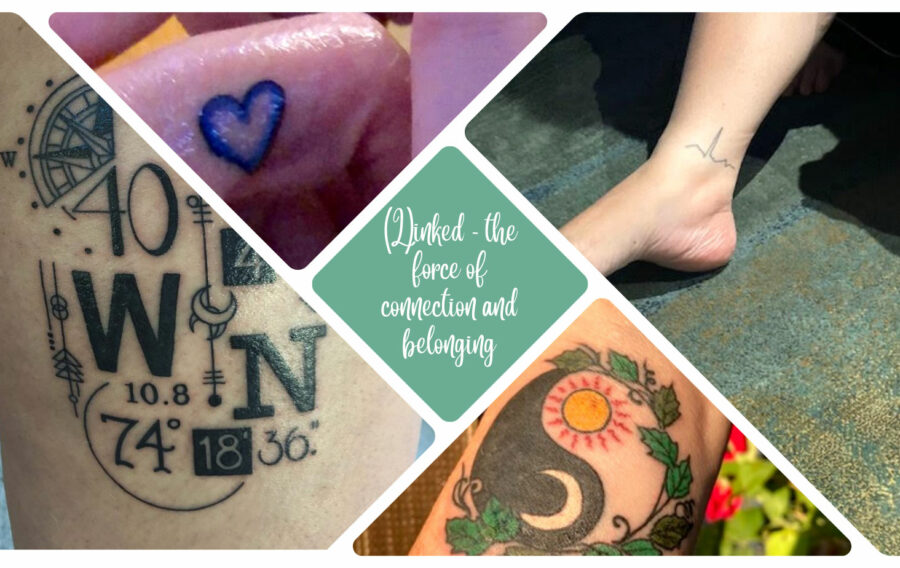
I have always admired the art of tattoos, and the historical significance they hold in many communities. We can see how the recent fame of Quannah Chasinghorse, who is Hän Gwich’in and Oglala Lakota, has given space to speak to the cultural reclamation of tattooing, and we can also see how the wider cultural uptake of tattoos has also reduced their “shock” value that might have existed a mere 20 years ago. I mean, even our Prime Minister of Canada has one, even though it is politically contentious due to its design. Many of my friends have tattoos that are symbolic of life transitions, remembrances, or transcendent life experiences. Some belong to communities where tattoos are a visual badge of belonging. Still others have used tattoos to reclaim self injured skin. And what I am discovering is that where there is a tattoo, there is a story.
Every year when my birthday rolls around, my thoughts turn toward getting a tattoo. I’ve thought about this for, well…at least 35 years. And amazingly, the design that I envision has not changed much over these many thoughtful, risk adverse years. We discuss risk aversion in RO DBT as being a characteristic of overcontrol (OC) coping, but don’t be fooled! Avoidance of risk is in reference to unplanned risk – such as joining in spontaneously, changing up your personal rules, trying something new, and so on. Planned risks, on the other hand, might include public performance or speaking, skydiving or flying a plane (like one famous OC we know and love, nudge, nudge, Erica Smith Lynch). Planned risks sometimes look much riskier, but if we think about it, they require an enormous amount of preparation and often involve safety checks and someone who is an expert coach or accompanying you. This is especially relevant for assessment, as all “risk” is not so risky with some investigation! In my mind, tattoos fall into the category of planned risk – you need an image, you need an artist and you need some time set aside. I have been delighted to collect stories from my fellow RO DBT therapists who have, in their time, gotten “inked.”
Now, some of our RO DBT therapists were into tattoos long ago. Consider this story from Larry Dahmer:
I got one of my wife’s name when we were in Florida Dec 31, 99. Last day of the millennium…was a playful way to connect with her….we had quite a few laughs at her “dare” that I do it. I probably wouldn’t have done it on any other day any other place, but it was a significant time. What I didn’t figure into the plan was all of a sudden I couldn’t go swimming with our young kids, and they kept asking why I had a “sticker” on my hip…lol.
Mr. Dahmer has not provided evidence of said “sticker,” but I can assure you he is a trustworthy guy. And what stands out for me in his story is that it sounds like his wife knew him well as an OC, hence the dare! I also have it on good authority that they remain happily married, which I would imagine would be important getting a name tattooed on you!
Others have waited a long time for their first tattoo, including Michael Vurek, who told me:
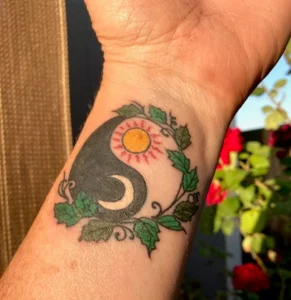
Attached is the tattoo that I got this past Father’s Day at age 67. I had also thought about it for many years, and just hadn’t gotten around to it. On Father’s Day and birthdays my family is always bugging me about what I want to do and I avoid making plans, so I felt quite brilliant to hit on getting a tattoo…plus this way I would not have to pay for the whole thing! My daughter, who is a planner, arranged the visit to the guy who has done extensive and lovely work for her. I was always pretty sure that I wanted the Yin-Yang symbol on my inner wrist. The symbol has various meanings for me: the tension of opposites; a dialectical worldview; the interplay of form and emptiness; the swirling movement and sensitivity to subtle changes in Tai Chi; and observing phenomena arise out of interdependence. These are all touchstones for my work as a therapist, as well. I love skies and the complimentary energy of sun and moon through the cycles of a day and the seasons. I constantly seek out opportunities to experience the rising and setting of the sun and the moon. The vines were an artistic touch and connect me to my daughter, as her tattoos have much of that element. It turned out a bit bigger and more colorful than I imagined earlier in the process of exploring designs, but as the artist developed the image I decided to go for it. He didn’t push it at all, but did tell me to never expect a tattoo artist to want to do less!
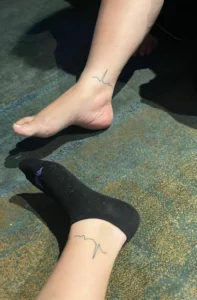
Ellen Astrachan-Fletcher, who for the record, identifies as UC, sent this:
My whole family got this one (my daughter and I have it on our ankles and my two sons and my husband have it on their chests over their hearts). It is a tattoo of my heart beat, as taken by my apple watch, when my kids and our dog Nugget, were hugging me. I fricking love my tattoos!
Now, if you recall your lessons 2 and 3 from the Skills Manual, deep pressure is effective for activating our social safety state, a.k.a., our ventral vagal complex. And here it is in full colour! In my thorough investigative reporting, I can assure readers that Nugget the dog does not have a matching tattoo.
This good doctor, as she says above, loves her tattoos and also sent this one:
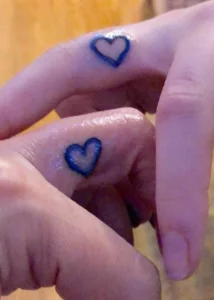
Here is a picture of my finger heart tattoo with my daughter. One day she told me that we needed to get finger tattoos so that when I was not available she could look at the tattoo and feel connected to me and it would help her think about what I might say. This was during the time that my best friend was dying from pancreatic cancer. I went to DC to help her for a week and I told her about how Sara wanted us to get tattoos. I expressed concern that no one gets their first tattoo after age 50. She looked at me and she said “Ellen, you have to get this tattoo.” I called my daughter right then and told her we would get the tattoo when she comes home for winter break. My friend died at the end of September and Sara and I got a blue layer on our hearts for Kim.
Julianna Gorder shared her thoughts on her tattoo:
The crescent moon has been a symbol that has held meaning in my life long before I was first introduced to RO DBT, and over time I have come to realize that the meaning this symbol has held parallels several important principles in RO DBT: 1) We don’t know what we don’t know. To me, the crescent moon represents the reality that in any given moment our perception captures only a limited piece of the full picture. When we see a crescent moon, we can see a sliver of light, and yet we can also recognize that there is a large part of the picture that is beyond our perception. 2) When we are in a closed mind, we are unable to hold space for the possibility of change, which keeps us stuck. When we are in Fatalistic Mind, we are telling ourselves that change is unnecessary because there is no answer (we cannot see the light), and when we are in Fixed Mind we are telling ourselves change is unnecessary because we (we have seen all there is to see, and are unable to acknowledge the fact that there may be more than we can perceive). During times in my life when I have been stuck, a mantra that has helped me stay the course is, “If there is sliver of possibility, I need to try.” This dialectic of holding hope for what could be (seeing the sliver of light), while also accepting the unknown (acknowledging that even though there is darkness, the full picture will reveal itself over time) has been behind the most transformative turning points in my life. After a particularly OC debacle that almost cost me my left index finger, I decided to get a tattoo of a crescent moon in that very spot! Stay tuned for a future blog on how RO DBT and finding the sliver of openness saved my finger!
Honestly, Dr. Gorder’s cat and finger story is the stuff of legend in RO DBT circuits, so I highly recommend reading her blog when it comes out!
Lindsay Johnson wrote to me and shared:
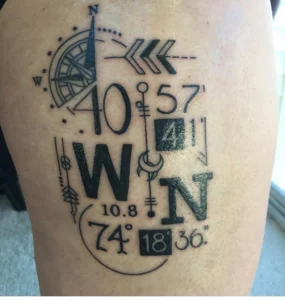
I got my first tattoo after I returned home from a 6-month volunteer trip in India. To me, the ink commemorated a life-changing experience and reminds me every day of the beautiful and extraordinary memories I have from those precious months. That first tattoo seemed to ignite something inside me, and since then I have gotten 5 others that each have a personal and significant meaning. One of those six is a piece on my leg that includes a variety of numbers and symbols that represent the connections to my family. Included are the coordinates to my childhood home, where I have some of the best memories of wiffleball games, backyard barbecues, and Christmas’s filled with love, laughter, and family. There are three triangles representing me and my two brothers, and two circles for my parents. Lastly, hidden within the design is my wedding date and two intersecting moons that pay homage to my love and marriage to my best friend. While I’d like to think that I’m done with my tattoos for a while, the reality is that I’m always thinking of my next one! Now that I’ve birthed two little ones into this world, I feel like that may be my next design…but I want to give it some more thought!
So, what do all these stories have in common, despite the symbols being very different? In each, we see the force of connection – to people living, to people past, to deeply held values. In writing this, I was reminded that although tattoos are “personal” choices, they are also embedded in community and signify our belonging. I have pledged that my own tattoo will be my gift to myself for my 50th birthday down the (short) road. It will still be my original image of crows; my favourite birds for many reasons. But I might need one of my co-writers here to hold my hand!
Thanks to everyone who has contributed to this blog:
Michael Vurek, LCSW, Supervising Therapist, DBT Center of Marin (just north of San Francisco) and infiltrator from the ACT community.
Larry Dahmer: Works at Health Sciences North in Sudbury, Ontario, and is still very happily married to Kathy after 28 years! And yes, still has her name tattooed on his left hip.
Julianna Gorder is a clinical psychologist at UC San Diego Eating Disorders Center. She loves cats and reality TV!
Dr. Lindsay Johnson is a therapist in New Jersey who focuses on treating college students with high perfectionism, anxiety disorders, and substance related issues. She loves competitive sports, spontaneous dance parties, and anything Christmas related.
Ellen Astrachan-Fletcher, PhD, FAED, CEDS-S, is the Regional Clinical Director at Eating Recovery Center and Pathlight Mood and Anxiety Center. She is a lecturer at the Feinberg School of Medicine, Northwestern University and Associate Professor of Psychiatry at University of Illinois at Chicago. She has 30 years of clinical and teaching experience in the field but she has over 55 years of learning ?.
J. Nicole Little remains un-inked, but her tribe loves her anyway.